Matador Network's Blog, page 1210
December 3, 2018
Best outdoor adventures in Namibia

Adventure seekers may not immediately think of Africa when searching for action-packed destinations, trekking instead to major outdoor hubs like Iceland, New Zealand, and Peru. But the continent is flush with unbeatable outdoor adventures, and nowhere are they more abundant than in Namibia.
Namibia draws its name from its massive emptiness, as namib is a Nama word literally meaning “vast place.” This huge expanse in southwestern Africa is one of the most sparsely populated countries in the world. Namibia has seemingly endless deserts and unbelievable wildlife, and it’s home to one of civilization’s oldest cultures, the San people. Here’s why the country is perfect for anyone seeking non-stop excitement.
The landscape is surreal and ancient.
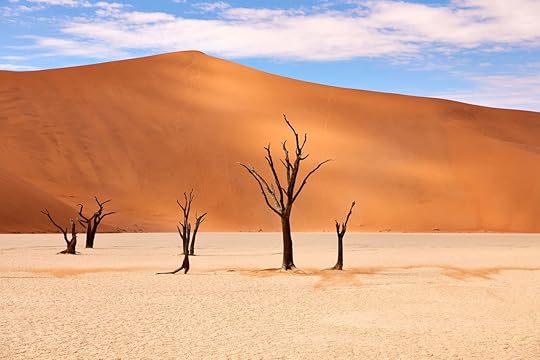
Photo: ArCaLu/Shutterstock
Namibia has truly been swept through the sands of time — 55 million years of it to be exact. The Namib Desert is recognized as the planet’s oldest desert and can best be explored within Namib-Naukluft National Park. At a staggering 19,216 square miles and encompassing both the Namib Desert and the Naukluft mountain ranges, it’s the largest wildlife reserve in Africa.
The desert offers unusual terrain, constantly changing as you travel through the country. This includes Deadvlei, a clay pan of darkened tree skeletons, which cannot decompose due to the dry climate; Fish River Canyon, which is as impressive as the Grand Canyon but without the crowds; and Dune 45 with its elegant beauty. The Namib Desert is made for hiking, four-wheel driving, photography, and other epic sand-dune sports.
It’s home to one of Africa’s best national parks.

Photo: Ondrej Prosicky/Shutterstock
Etosha National Park is one of the best places in southern Africa to see wildlife, including the Big 5 (leopards, lions, rhinos, elephants, and Cape buffalos) and a huge range of birdlife, gazelle and antelope, and other African species. Although wildlife can be spotted at any time of the year, consider visiting in the dry season between May and December. Etosha is known for its watering holes, and much of the park is made of salt flats, making water a scarce commodity. In the dry season, animals are drawn to the watering holes, making wildlife easy to spot.
Game drives with a local guide are an epic way to see the 8,600-plus-square-mile park. Guides have expert knowledge on the flora and fauna of Etosha. Anything can happen on a game drive; the sheer terror of coming across a bull elephant on the road, charging directly for your vehicle (and then veering off at the last minute) is not something you’re likely to forget anytime soon.
You can fall asleep to the roar of lions.

Photo: Zaruba Ondrej/Shutterstock
Falling asleep to the roar of lions is both terrifying and extremely memorable. You can camp in Etosha National Park’s designated various camping areas. Since Etosha is so remote and unspoiled, it’s also a fantastic place for stargazing and watching the night sky.
Although protected from the wild, the campgrounds are still very close to the habitat of the park’s animals. If you’re lucky enough to stay at Okaukuejo Camp, it’s best known for its floodlit waterhole, making for prime wildlife viewing both day and night. The watering holes attract creatures big and small, including lions. If you are lucky enough to hear it, the sheer power from the roar of a lion is hard to describe — but it does quickly remind you of your place on the food chain within Etosha. As I drifted off to sleep, all alone with just my tent for company, the flimsy structure suddenly no longer felt as secure as it did in the daytime.
Adventurous foodies will love it.

Photo: urosr/Shutterstock
Namibian cuisine is best known for its wild game. Try a grilled steak or barbeque of kudu, eland, or springbok (all part of the antelope family), zebra, or crocodile, each of which is a delicious Namibian delicacy. Biltong, or dried meat, is also popular and makes for an easy snack on the road.
Mopane worms are a unique specialty of the Oshiwambo community, and you need to try them while in Namibia. They’re actually small caterpillars, usually served fried, and are an important source of protein for many in southern Africa. Although the Namibian food scene is heavy on meat, you can usually find vegetarian options when traveling.
It’s a haven for German beer aficionados.
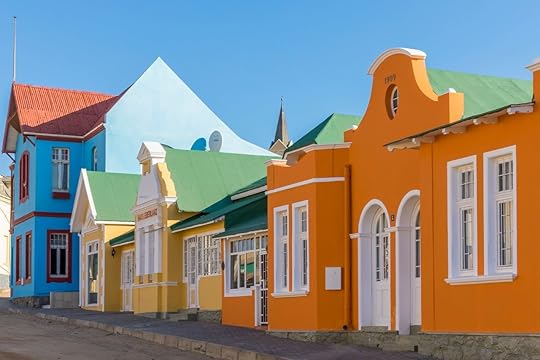
Photo: Gunter Nuyts/Shutterstock
If caterpillars don’t strike your fancy, delicious chicken schnitzels and German beers on tap are aplenty in Namibia, given the lasting impact of German colonization. Look for German restaurants, architecture, and influence, especially in Windhoek, Walvis Bay, and Swakopmund. If you find yourself on a road trip anywhere near the outpost of Solitaire, step into the bakery for the famous apple strudel, a delicious and unexpected taste of old-world Europe in the Namibian desert. It’s the only real shop and gas station between the Sossusvlei dunes and the coast of Walvis Bay, a perfect excuse for stopping for dessert.
Swakopmund was made for extreme thrills.

Photo: WJRVisuals/Shutterstock
Adrenaline junkies need to spend a few days in Swakopmund. This town is the perfect base to explore the Namib Desert and is the premier location in the country for adventure sports. Try sandboarding down the dunes, quad biking, or four-wheel driving through Sandwich Harbour, where the dunes and the Atlantic Ocean meet dramatically. Many tour operators offer discounts if you book multiple tours, so consider going with the same company if you have a few activities you want to try.
Skydiving, hot-air ballooning, and 4WD nature and wildlife tours are also popular in this seafront town with a large number of guesthouses and restaurants catering to tourists. For a special treat, consider splurging for dinner at The Tug, a waterfront seafood restaurant known for its fresh fish and a favorite of Swakopmund frequent Angelina Jolie.
Dune 45 and Big Daddy will leave you breathless in more ways than one.

Photo: Cezary Wojtkowski/Shutterstock
Two of Namibia’s most famous sand dunes, Dune 45 and Big Daddy, both within the Sossusvlei region, are highlights of any trip to Namibia. Big Daddy is known for being the tallest dune in the region while Dune 45 is known for its easy access and title of the most-photographed landmark in the country.
Climbing barefoot is easier, and your shoes would quickly fill with sand, anyway. The imposing dunes, with their impossibly perfect shapes and angles, present an enticing challenge to hikers and are hard to resist. However, the dunes are deceptively large, so don’t underestimate the time it takes to reach the peak. Set off at sunrise to avoid the midday heat. The orange-red sand will still be cool, and the windswept dunes create constantly changing geometric designs and shapes. No two visits will ever be exactly the same. 

More like this: How to plan a do-it-yourself African safari on a budget
The post Namibia is the most underrated outdoor destination in Africa appeared first on Matador Network.

The best 'ruin bars' in Budapest
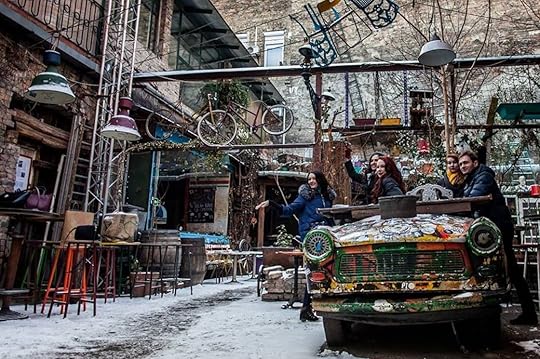
Budapest is famous for its nightlife. Few, if any, Central or Eastern European cities match the bars and clubs of what’s known as both the Queen of the Danube and the Heart of Europe. And to see the true heart of Budapest, you have to go to the romkocsma, or ruin bars.
Ruin bars are exactly what the name suggests: abandoned, derelict buildings that have been transformed into local watering holes. Concentrated primarily in the city’s Jewish Quarter in the seventh district, ruin bars vary widely in style and offerings but are the collective heart of Budapest’s inner city. Most have an open-air courtyard, eclectic and mismatched furniture, and, in general, cheap beer and food. They’re also where you can find both locals and in-the-know tourists. But it wasn’t always this way.
Ruin bars and the thriving nightlife scene in Budapest are relatively new, but their roots date back to WWII. Hungary fought alongside Nazi Germany and the Axis powers for much of the war. During that time, Budapest’s Jewish population was deported to death camps or forced into a district that had been converted into a ghetto. Germany turned on Hungary and occupied the country in 1944, just before the end of the war. Soviet Union occupation followed and lasted up to the dissolution of the USSR. During that time, many of the abandoned apartment buildings and warehouses in the seventh district crumbled into disrepair.
In the early 2000s, a group of young entrepreneurs wanted a community space for hosting cheap parties and events. In 2004, the first ruin bar, Szimpla Kert, opened in a run-down building at 14 Kazinczy Street. Without money to invest in upgrading and furnishing the place, the owners and regular patrons brought in whatever bits and bobs they could, and the bar gradually took on the eccentric, mismatched appearance that it’s renowned for today.
Others quickly followed. Investment in the Jewish Quarter grew with the popularity of ruin bars, and developers took advantage of the cheap buildings. Over the years, the trend spread to other districts, sometimes with bars only open for a few months. Ruin bars went from a gritty place to grab a beer to a commercial investment to the established institutions they are today.
The role ruin bars play in Budapest’s culture

Photo: robertonencini/Shutterstock
It’s not all about the party. In February 2018, a referendum was held for the residents of the Jewish Quarter regarding a rule that all bars and clubs close between midnight and 6:00 AM. With barely 15 percent of residents showing up to vote, the result was declared invalid, and therefore the rule was not implemented. This would have undoubtedly damaged the nightlife scene in the city and been the ruin of the ruin bars.
It’s easy to understand where the residents who support the closing times are coming from. The party scene is pumping every night of the week, bringing noise pollution and unruly tourists. However, ruin bars are inextricably linked to the soul of the city, and most residents can’t image Budapest without them.
Part of the reason is that ruin bars aren’t just about drinking. During the day, some of the spaces are converted into flea and farmers markets where you can shop for authentic Hungarian delicacies and support local producers. Two of the best include the Szimpla Kert farmers’ market (every Sunday from 9:00 AM to 2:00 PM) and Finom Placc at Ellátó Kert (every Wednesday from 5:00 PM to 9:00 PM).
If you’re seeking a night out on the town, a cozy corner to listen to some live music, or a market filled with Hungarian specialties, then there’s a ruin bar for you.
The best ruin bars in Budapest

Photo: Szimpla Kert/Facebook
Szimpla Kert: The ruin bar that started it all has become a major tourist attraction. Opened in 2004, Szimpla Kert (which translates to “simple garden”) has its own souvenir shop. On any given night of the week, a line of people stretches out onto the sidewalk, waiting to get a glimpse of the bar.
Once inside, you’ll see that it clearly lives up to the “garden” in its name. Szimpla Kert has a maze-like layout with a collection of interesting objects in every nook and cranny of the building. An old Trabant car, for example, and a room full of old computer screens. Tires and bathtubs are used as seating, and artwork covers every inch of the crumbling walls.
Despite the international attention, it’s still a community center. Events for both locals and travelers are held during the day, like the local-focused Hungarian farmers market where pastries, salami, cheese, preserves, and fresh produce is sold.
Anker’t: Open only during the summer months, Anker’t is one of the largest outdoor beer gardens. It’s also one of the most hidden and is still more of a spot for locals. The focus here is on the culture. Anker’t hosts vegan markets, poetry slams, and art exhibits in addition to serving as a place to drink a cold beer.

Photo: ELLÁTÓkert/Facebook
Ellátó Kert: Also located on Kazinczy Street is Ellátó Kert (“provider garden”). The bar is filled with Mexican decor and serves food like tacos and drinks like margaritas. There are also popular fröccs (spritzers) and grapefruit-vodka shots.
It recently started hosting a small food market, Finom Placc, on Wednesday evenings. It is smaller than Szimpla, but no less delicious, and has a local vibe.
Red Ruin Bar: For something a bit different, you can head just outside of the Jewish Quarter to the Red Ruin Bar. The walls of this small bar are filled with pop art mocking fallen communist regimes and leaders. Go for a local beer and plenty of the national fruit brandy, palinka. 

More like this: How to save money on your trip to Budapest
The post How ‘ruin bars’ became the hottest drinking spots in Budapest appeared first on Matador Network.

The world’s weirdest superstitions

To truly experience a new place or culture, you must embed yourself in local customs. Food, history, and language often top the list for experiential travelers, but one important factor of a society’s culture often goes overlooked — superstitions. Legends, tall tales, and belief systems can be as much a part of someone’s way of life as what’s on their dinner plate, so insurance firm Compare the Market analyzed 10 of the world’s most unique superstitions to help travelers act accordingly.
1. Odd goodbyes

Photo: Compare the Market
In India, calling out to someone as they leave the house is believed to be bad luck, the study notes, urging you to say everything you need to say prior to a friend or family member’s departure.
2. Avoiding the 17th

Photo: Compare the Market
Many Italians believe the number 17 to be an anagram for VIXI, meaning “I have lived” — a symbolic way to indicate death. As such, they avoid traveling on the 17th day of the month and generally view the day with the same disdain with which many Americans dread Friday the 13th.
3. Avoiding the number four

Photo: Compare the Market
For the Chinese, the number to avoid is four. Many buildings simply omit the fourth floor, with escalators shuffling passengers from the third straight to the fifth.
4. Sitting on your suitcase

Photo: Compare the Market
A moment of reflection is thought to be a good thing for Russian travelers, who are known to sit atop their luggage and reflect on the upcoming journey in a bid for good luck.
5. Wetting the path
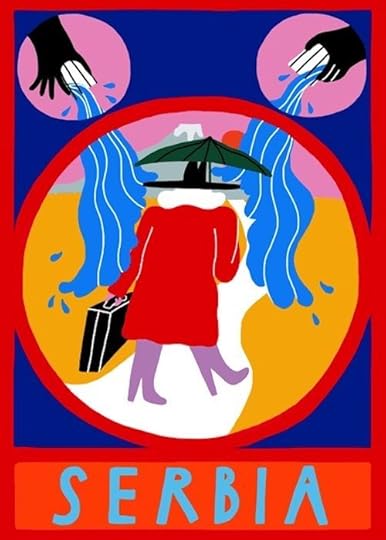
Photo: Compare the Market
Serbians believe that good luck comes from someone spreading water out in front of you before you head out.
6. The friendly curse

Photo: Compare the Market
Curses are often thought to be a bad thing, but not necessarily so in Norway. A common Norwegian saying, “tvi tvi,” is thought to prevent evil spirits from descending upon a traveler — or just about anyone else.
7. The friendly black cat

Photo: Compare the Market
In the US, we tend to avoid black cats crossing our path, especially on Friday the 13th. The opposite is true in the UK, where black cats are said to be an omen of good fortune.
8. Headed south

Photo: Compare the Market
The Japanese believe that sleeping with your pillow facing north shortens your life, which is why you may encounter some odd pillow placements when on a trip to Japan. Better hope that compass on your cell phone is in proper working order.
9. In and out
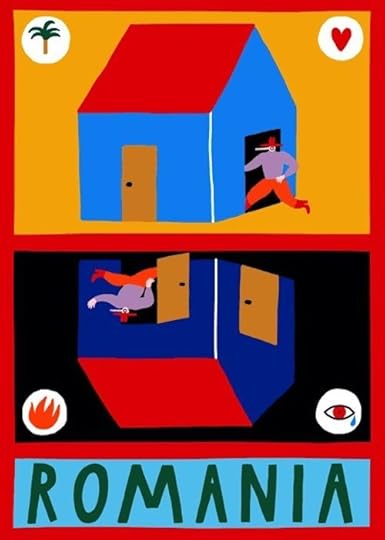
Photo: Compare the Market
Romanians believe leaving through a different door than the one in which you entered brings bad luck.
10. The straight and narrow
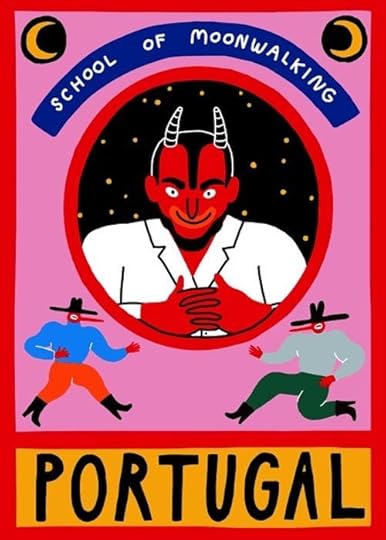
Photo: Compare the Market
People in Portugal aren’t fond of moving backward. Rarely will you see a Portuguese person doing the moonwalk or any other slick moves that may cause them to retrace their steps, because they see walking backward as an invitation for the devil to follow your path. 

More like this: The 6 weirdest superstitions the French have
The post The world’s craziest superstitions that every traveler needs to know appeared first on Matador Network.

The worst US airports for delays

Traveling around the holidays is no easy feat, with airports full of irritated people rushing between terminals, pushing mountains of luggage, and stressing out about their impending family time. To make matters worse, the high volume of travelers often leads to flight delays.
This chart, created by Asher & Lyric, breaks flight delays down so that you can avoid the worst US airports for delays this holiday season.

Photo: Asher & Lyric
Click here to zoom in on the chart.
To create the chart, Asher & Lyric used domestic flight data from the Federal Aviation Administration and the Bureau of Transportation Statistics. Taking the top 25 busiest airports in the US, the blog looked at the percentage of on-time flight departures, percentage of canceled flights, average departure and arrival flight delays, average taxi time, and average wait time at customs.
According to the findings, New York’s JFK is the worst airport in the US for delays. Only 77 percent of its departing flights leave on time, and the average delay for departures is 72 minutes. It also has the most cancellations, and particularly long taxi times. LaGuardia and Newark, also in the NYC area, performed poorly as well, along with Chicago’s O’Hare International Airport.
Among the country’s most punctual airports are the ones in Phoenix, Atlanta, Las Vegas, and Los Angeles. While there may be no single definitive reason why some airports are able to reduce delays while others aren’t, warm-weather cities may have a slight advantage because of their consistent favorable meteorological conditions. 

More like this: The 5 most entertaining airports for a long layover
The post The worst US airports for delays that you should avoid this holiday season appeared first on Matador Network.

Paris trashed by destructive riots

This weekend, Paris was stunned by violent riots ignited by nationwide unrest over high fuel taxes and living costs. Protesters, wearing fluorescent, yellow jackets, defaced historical buildings, vandalized cars, and broke the windows of fancy shops. Now, city workers are struggling to clear the chaos left behind from this tumultuous weekend.
The worst of the riots is thought to have been caused by anarchist and anti-capitalist fanatics, from both the far right and far left. The riots’ main targets appeared to be banks, insurance companies, expensive homes, and high-end boutiques and cafes.
In the course of the riots, 400 people were arrested and over 100 inured, with police battling protestors amid some of the city’s most iconic monuments. The Arc de Triomphe was the setting of one of these dramatic clashes, and the target of vandalism. “I’ve worked on monuments around Paris for 20 years,” said a Paris City Hall official overseeing the cleanup, “and I’ve never seen anything like this at the Arc de Triomphe.” Hundreds of laborers are also working to replace the glass panes of a Dior store on the Rue Royale. Other high-end retailers in the area, including Gucci and Chanel, suffered damage as well.
In the face of nationwide unrest, the government is considering declaring a state of emergency. Claude, a woman living next to the Belle Armée brasserie, which was set on fire during the riots, said, “The violence is escalating at an exponential rate. The state is losing control. They cannot let this happen. Maybe the army should intervene.”
The protests certainly put a damper on the start of France’s holiday season. Paris’ streets should have been busy with Christmas shoppers this weekend, but instead they were defined by violence. 
H/T: Reuters

More like this: 7 lesser-known Parisian architectural wonders you can check out for free
The post Paris in shambles after “Yellow Vest” riots last weekend appeared first on Matador Network.

Most affordable American cities

Hasbro made headlines recently when it taglined its new Monopoly for Millennials game, “Forget real estate, you can’t afford it anyway,” which, while humorous, is only accurate in a dozen or so cities. If you’re not looking to move to San Francisco, Seattle, Boston, New York City, or other A-list locales, housing is still pretty affordable. Of course, sometimes said affordable housing is in places you can’t really envision moving. Lovely as cities like Dayton, Ohio, and Lansing, Michigan, may be, they’re not likely to top any “fastest-growing” lists until climate change really kicks into high gear.
That said, there are some cities around the country where housing is still pretty cheap, the weather is nice, and cultural and recreational opportunities abound. While they may not have the high demand of top-tier metro areas, they offer most of the same amenities at a fraction of the price. Here are nine cities worth a look, where even millennials saddled with student loans can afford a house — and a pretty awesome quality of life.
1. Colorado Springs, Colorado
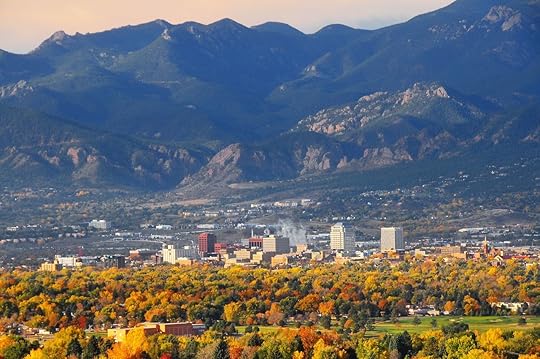
Photo: John Hoffman/Shutterstock
Median home price: $216,000
While the Rocky Mountain lifestyle of epic outdoors, craft beer, and legal marijuana has been drawing people to Denver for the better part of a decade, it’s also driven the median home price there well over $400,000 — and Boulder is double that. This is why the home of Colorado State University seems to be the next great Colorado destination with reasonable home prices. While it doesn’t have the airport accessibility of Denver or the college town cool of Boulder quite yet, it does have a major university and three big-time breweries in Fossil Craft, Smiling Toad, and Atrevida — and what you’re getting is comparable for half to a quarter of the price.
2. Greenville, South Carolina
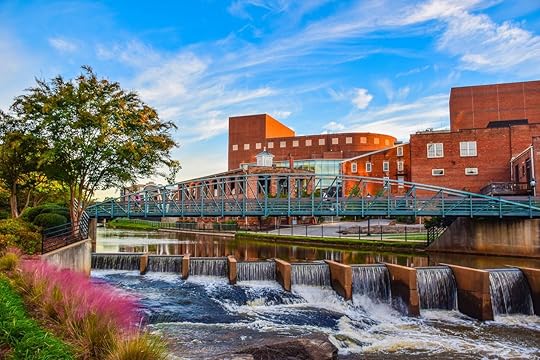
Photo: Kevin Ruck/Shutterstock
Median home price: $161,000
Greenville seems to be the model that many mid-size cities try to emulate, where a manageable population lives without much congestion or crowds. But things like restaurants, bars, and cultural events are on par with what you’d find in cities ten times its size. Greenville has not-so-quietly become known as the cheaper culinary alternative to Charleston, where chefs open up shop at a fraction of the cost, with food just as good, if not better. Greenville’s recent explosion has led to Travelers Rest, the small town on the other end of the Swamp Rabbit Trail that’s opening some of the South’s best new restaurants of the past couple years at Farmhouse Tacos and Monkey Wrench Smokehouse. Greenville’s secret is out, and if you want to live anywhere near its charming, walkable downtown affordably then you’ll need to do it soon.
3. Louisville, Kentucky
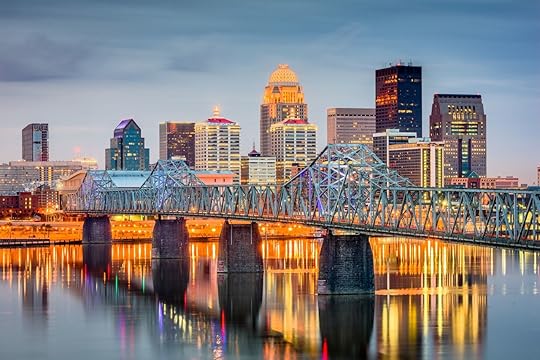
Photo: Sean Pavone/Shutterstock
Median home price: $155,000
Though most people won’t base where to live off proximity to whiskey distilleries, it’s still nice to know that if you live in Louisville then you can step out of your front door and be on the Kentucky Bourbon Trail in less than half an hour. The city famous for its whiskey and horse racing is drawing acclaim for things other than vices, with Top Chef recently filming an entire season here and National Geographic placing it on its list of top 10 food cities in the world. As smaller southern cities like Nashville, Raleigh, and Austin fill up with tech-minded millennials, Louisville is primed to be the affordable alternative. Groceries here are on average 10 percent less than the national average and utilities are 11 percent less, which will give you plenty of extra cash to wager at next year’s Kentucky Derby.
4. Tulsa, Oklahoma

Photo: Valiik30/Shutterstock
Median home price: $150,000
Tulsa is not unlike former industrial boomtowns around the great lakes, cities like Cleveland and Buffalo, whose gilded age billionaires endowed them with great cultural institutions. The oil money that’s flowed through Tulsa like the Arkansas River has given the city a world-class ballet, an opera, and two symphony orchestras. Plus, the best collection of Art Deco architecture in the middle states. The city recently added the Gathering Place, a massive, 100-acre riverfront park that’s transformed the city’s waterfront into an energetic hub for urban life. With relatively warm weather, affordable homes, and one of the greatest St. Patrick’s Day parties in the world, Tulsa won’t stay small for long.
5. Boise, Idaho
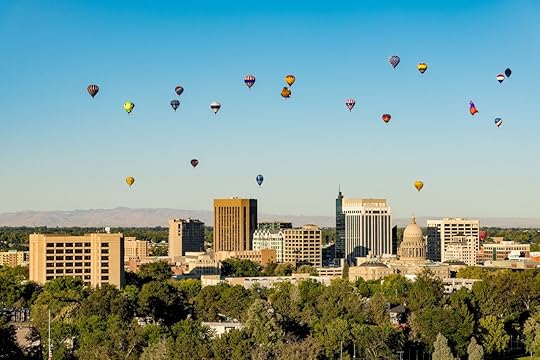
Photo: Charles Knowles/Shutterstock
Median home price: $215,000
Boise has been touted as “the next Portland” for a few years now, though it hasn’t quite achieved that level of quirky Northwestern-ness, which may be a good thing. Boise hits all the notes one looks for in an outdoorsy Northwestern town — proximity to skiing, beautiful scenery, green space, and beer, all at a third of the cost you’d find in big coastal cities. It’s only a few hours’ drive from the popular slopes in Utah, and even less time to Sun Valley or Coeur d’Alene in Idaho. It also opened a 25-mile greenbelt along the Boise River, allowing for ample recreational opportunities during its 200-plus sunny days. April also brings Idaho craft beer month to Boise, where 30 days of events highlight local breweries like Payette Brewing, Highlands Hollow, and Grand Teton.
6. Las Vegas, Nevada
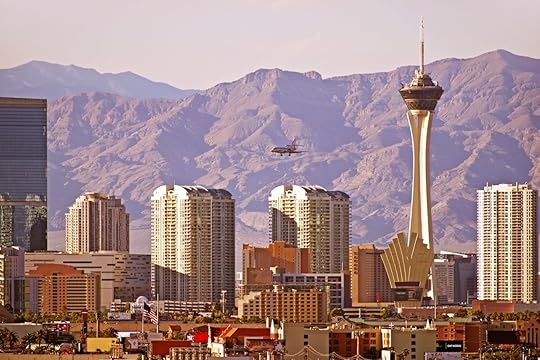
Photo: welcomia/Shutterstock
Median home price: $240,000
With world-class restaurants and nightlife along the strip, Vegas has never been an under-the-radar city. But off the strip, recreational opportunities out in the desert abound, and a stellar local scene is emerging near downtown. Now that it’s on the verge of getting two professional sports teams, we can officially say that Vegas is transforming itself from a place built for tourism into a legitimate American metro. The housing crash of 2008 hit Vegas harder than anywhere else, and the overstock of residential units still makes this place surprisingly affordable for a city with all that it offers. But as tax-and-disaster-weary Californians begin to see this warm weather alternative as a viable living option, prices might not stay under a quarter-million for long.
7. San Marcos, Texas
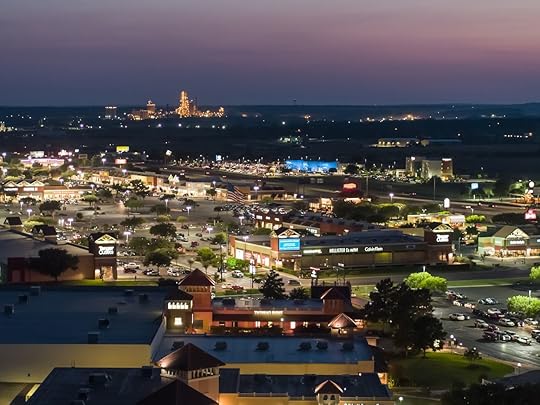
Photo: Felix Mizioznikov/Shutterstock
Median home price: $207,000
All the things that used to draw people to overcrowded Austin — colorful characters, abundant live music, and the world’s best barbecue — have been pushed south to San Marcos. The home of Texas State University has taken over the state’s mantle as college town home of the weird, where returning vets, artists, and musicians priced out of Austin have found a new home at the headwaters of the San Marcos River. During almost any night, you can stroll the Square and visit one of the best live music scenes in America at spots like Stonewall and Cheatham Street Warehouses (where George Strait got his start). Unlike Austin, San Marcos has planned for its growth, and though it’s among the fastest growing cities in America, it still doesn’t feel crowded. And, for now anyway, San Marcos has managed to stay weird.
8. Phoenix, Arizona

Photo: Dreamframer/Shutterstock
Median home price: $240,000
The Valley of the Sun has been growing at a breakneck clip for decades now, but many people would credit that to an influx of retirees from the Midwest. But Arizona State University opened its downtown campus in 2006, and since then the once nonexistent downtown Phoenix has become the cultural hub of Arizona. Chefs like Aaron Chamberlin have led the charge by putting his Public Market Café next to a weekly farmers market that draws thousands. It sits just blocks from the Roosevelt Row Arts District, where murals, funky coffee shops, and art galleries sit on lots owned by artists (meaning they won’t be torn down for condos anytime soon). Add in one of the best cocktail bars on the planet at Bitter and Twisted and you’ve got perhaps the best affordable downtown in the US.
9. Jacksonville, Florida

Photo: ESB Professional/Shutterstock
Median home price: $170,000
You’d be hard pressed to find an American city with over 20 miles of beach, professional sports, a major airport, and a historic downtown where you can still live on the ocean for less than a million dollars. But as people still imagine Jacksonville as the backwater home of Lynyrd Skynyrd, prices in the River City have stayed low. Jacksonvillians don’t seem to mind this, as there’s still plenty of parking in charming beach towns like Atlantic Beach and Neptune Beach, and the award-winning restaurants like Orsay and Town Hall are still accessible to regular people. Though living on the beach isn’t cheap, you can still get a waterfront home here for half a million dollars, or a historic home in the downtown-adjacent San Marco for even less. Though people poke fun at Jax, it’s still the best coastal deal in Florida — and one you should jump on while you still can. 

More like this: The 25 coolest towns in America: 2018
The post 9 cities you should move to while you can still afford them appeared first on Matador Network.

Most beautiful Christmas trees

If you need a little help to get into the holiday spirit this year, get yourself a winter drink with a side of holiday treats and a tour of the world’s best and most elaborate Christmas trees. These towering pines (or sand piles, in some cases) are decked to the nines and shine brightly for celebrants around the world to enjoy.
1. Zócalo Christmas tree — Mexico City, Mexico

Photo: Henryk Sadura/Shutterstock
Christmas time in Mexico City welcomes the return of a gigantic tree in Zócalo Square. With the Metropolitan Cathedral behind it, the holiday display makes Centro Histórico even more scenic than it already is. In past years, the Christmas experience in Zócalo Square is completed with a nearby ice skating rink and even a light and music show.
2. Rockefeller Center Christmas tree — New York City, New York
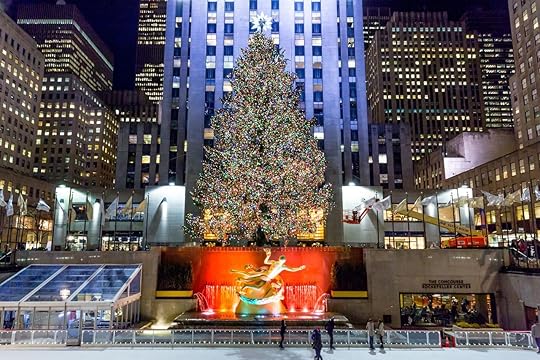
Photo: MACH Photos/Shutterstock
When it comes to Christmas decoration, you just can’t beat New York City. Perhaps the most famous Christmas tree in the world, the Norway spruce at Rockefeller Center usually has a height between 70 to 100 feet and is a sight to behold each year. The brilliantly lit tree is a long-standing American tradition dating all the way back to 1933 when construction workers were building Rockefeller Center. The tree typically has five miles of string lights and a 10-foot star topper made of Swarovski crystal. And not only does the tree cheer you up during the holiday season, but once it’s taken down in early January, the lumber is donated to Habitat for Humanity for in-house construction use.
3. Sandi — West Palm Beach, Florida

Photo: Courtesy of the City of West Palm Beach
Florida doesn’t get any snow during the holidays (or ever), so it makes do with what it has in abundance: sand. Beginning in early November, sand is delivered by the truckload to the West Palm Beach waterfront, where sculptors begin shaping the massive pile into a 35-foot Christmas tree. West Palm Beach’s Sandi tree is the world’s only 700-ton sand tree and is illuminated with choreographed light and music shows nightly throughout the holiday season. To complete the seaside setting, Sandi is flanked by four 25-ton sand sculptures shaped like mermaids, pufferfish, and other inhabitants from under the sea.
4. Floating Christmas tree — Rio de Janeiro, Brazil

Photo: A.RICARDO/Shutterstock
Revelers like to do it big in Brazil, and Christmas time is no exception. Rodrigo de Freitas lagoon in Rio de Janeiro is home to a floating Christmas tree that stretches over 270 feet into the sky, a tradition that began alongside a dazzling fireworks display in 2014. The tree has to be constructed on a barge each year and is lit up with more than three million lights. It took a two-year hiatus due to lack of funding but is making its return in 2018.
5. Galeries Lafayette Christmas tree — Paris, France

Photo: Nadiia_foto/Shutterstock
A stunning four-story Christmas tree is placed inside the Galeries Lafayette department store each year in Paris, France, and it always has a different theme to surprise and delight shoppers. Past themes have included “from another planet,” complete with meteoric decorations; “Arctic,” which was made entirely of paper by French artist Lorenzo Papace; and “Spectacular Spectacular,” from the film Moulin Rouge. This year’s tree is sponsored by luxury watchmaker Piaget and adorned in glittering greens and golds.
6. Gubbio Christmas tree — Gubbio, Italy

Photo: ValerioMei/Shutterstock
Few things could better inspire holiday cheer than a mountain-sized Christmas tree made from hundreds of real, live pine trees. In Gubbio, Italy, individual trees on the slopes of Mount Ingino are outfitted with an array of lights to create the stunning visual of a 2,000-foot Christmas tree spanning the mountain from base to peak. Even better, the world’s largest Christmas tree is switched on by a notable figure each year, such as the Pope in 2014 (and in 2017, it was switched on from space!).
7. Vilnius Christmas tree — Vilnius, Lithuania
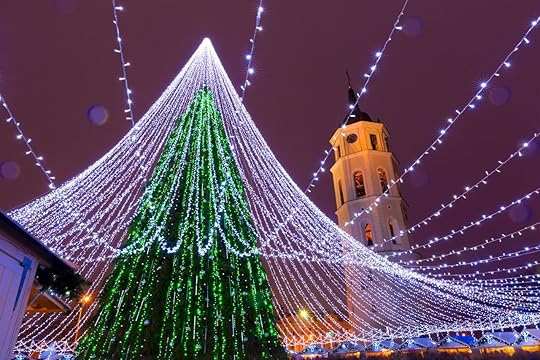
Photo: kavalenkava/Shutterstock
70,000 light bulbs shine together to make the Christmas tree in the center of Vilnius’ Old Town visible to anyone flying over the Lithuanian capital city. Set in Cathedral Square, the Vilnius Christmas tree is illuminated in a myriad of colors and even provides visitors with the chance to walk around under the blanket of lights, giving them the feeling of being inside the dazzling Christmas tree. Surrounded by a traditional Christmas market, the display also features Christmas toys and covers over 26,000 square feet in total.
8. Taipei Christmas tree — Taipei, Taiwan
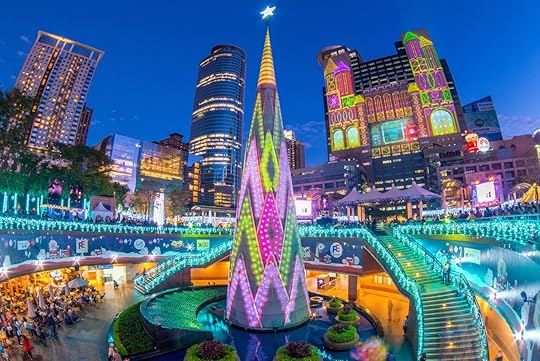
Photo: Richie Chan/Shutterstock
Situated in front of Taipei City Hall, the Taipei Christmas tree is the centerpiece that helps transform the entire area into what’s known as Christmasland, a full-on Christmas playground. Christmas is not a recognized public holiday in Taiwan, but that doesn’t stop its citizens from joining in on the holiday fun. Other highlights of Taipei’s Christmasland include a Christmas market, carolers, over-the-top decorations, and even a Christmas fair with rides.
9. Christmas at the Capitol — Pierre, South Dakota

Photo: Courtesy of the South Dakota Department of Tourism
Most people head to South Dakota for a glimpse of Mount Rushmore, but travelers visiting the state around Christmas can enjoy a walk through 90 Christmas trees on display at Christmas at the Capitol in Pierre. The trees are decorated by businesses, nonprofit organizations, communities, and government offices from all over the state of South Dakota. The official South Dakota Christmas tree is the centerpiece of the annual celebration and is decorated with ornaments and pine cone balls made by locals in Black Hills. 

More like this: 7 amazing Christmas markets you need to go to this holiday season
The post The 9 most dazzling Christmas trees around the world appeared first on Matador Network.

NYPD returns lost engagement ring

The giddy phase lovers experience after a wedding proposal was short-lived for this couple. After John Drennan popped the question in Central Park on Friday, him and his fiancée Daniella Anthony, both from Peterborough, England, were strolling through Times Square when the ring slipped off the bride-to-be’s finger and disappeared into a sidewalk grate. Although they did flag down a police officer to report the incident, the couple gave up hope after an hour’s search, and returned home to the United Kingdom shortly thereafter. John was so convinced that the ring was lost, he even bought a second ring to replace it.
“I was literally crying,” Daniella told The New York Times. “It was the worst moment of my life.”
CCTV images didn’t show the initial proposal, but did capture the couple’s frantic (and futile) attempts to recover the lost ring. Now, lucky for John and Daniella, the ring has been found thanks to the New York Police Department. Taking it upon themselves to rescue and clean the ring, the NYPD then put out a plea on Twitter, searching for the couple.
WANTED for dropping his fiancée’s ring in @TimesSquareNYC!
She said Yes – but he was so excited that he dropped the ring in a grate. Our @NYPDSpecialops officers rescued it & would like to return it to the happy couple. Help us find them?
Rites of passage from Wisconsin
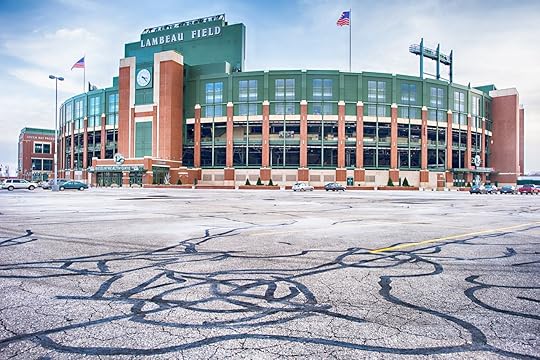
We all experience life milestones but, if you grew up in Wisconsin, you know that we have our very own coming-of-age rituals. Here are eight rites of passage every Wisconsinite goes through.
1. Your first Miller Lite
Your first Miller Lite is basically your initiation into adulthood, whether you obtained it at legal drinking age or snuck it out of mom and dad’s fridge. If we’re being honest, though, you probably snuck a sip out of a can when you were a kid.
2. Your first trip to Lambeau Field
You spent years as a kid watching the Packers play on TV, but nothing can prepare you for the excitement of seeing your first game at Lambeau Field.
3. Visiting the Dells
Every Wisconsin kid has a family vacation to the Dells. You’ll never forget the first time you barfed after swallowing too much water in the wave pool, or that time your parents lost you at the kiddie slides.
4. Learning how to cook the perfect brat
Learning how to cook a brat — first boiled in beer, of course — is an important step in your life as a Wisconsinite. If you learn to cook nothing else, you can survive on good beer brats.
5. Going to the bar with your parents
Whether for a Friday night fish fry or a Saturday morning meat raffle, it’s very normal for kids to go to the local bar with their parents.
6. Skidding into your first ditch while driving in winter
Everyone in Wisconsin has slid off an icy road and into a ditch. You’ve officially made it as a local when you find yourself spinning your tires on ice on the side of the road. Thankfully, there are some kind Wisconsinites out there with a tow rope at the ready to pull you out.
7. Seeing your parents embarrass you on the dance floor at the first family wedding
You had never seen your parents dance before, but there they were, polka dancing with your aunts and uncles while you and your cousins looked on, mortified.
8. Your first tick.
You’ll never forget your first tick. Your mom found it while giving you a bath, and told you she’d have to pull it off and burn it. The ordeal was enough to make you stay inside for a few days. 

More like this: 9 signs winter is coming in Wisconsin
The post 8 rites of passage all Wisconsinites go through appeared first on Matador Network.

November 30, 2018
Best frozen lakes for ice skating
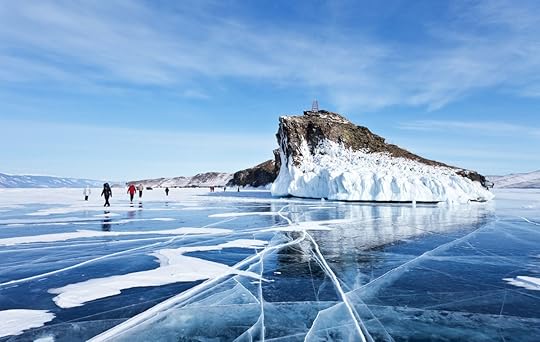
Skating out in the clean, crisp winter air surrounded by trees or mountains is a unique feeling. A far cry from the crowds and Christmas-carol soundtrack of an urban ice rink, gliding silently over the surface of a vast frozen lake is exhilarating. From Canada to Switzerland, winter transforms already stunning lakes into the world’s most spectacular natural skating surfaces. Whether in far-flung pockets of Alaskan wilderness or big cities like Stockholm, these frozen lakes all turn a simple winter sport into an enchanting commune with nature.
Lac de Joux — Jura Mountains, Switzerland
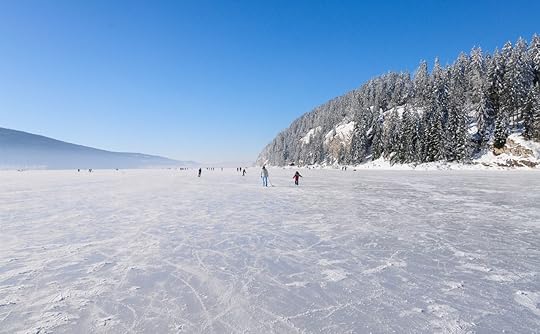
Photo: Richard Cavalleri/Shutterstock
The Jura Region lies in a 190-mile arc of limestone hills along the border of France and Switzerland. In the steep Vallée de Joux, at an altitude of almost 3,300 feet, is Lac de Joux, an enormous alpine lake, which during the colder months becomes the largest natural ice skating rink in Europe.
Ringed by barren alpine forest, the lake’s surroundings possess a stark, frost-tinged beauty. Even when large numbers of visitors descend on the Jura Mountains in the peak months of February and March, the sheer vastness of the lake means speed skating in the wide open of Lac de Joux is nothing short of thrilling.
Lake Morey — Vermont, United States

Photo: Lake Morey Resort/Facebook
Skating the entire length of Lake Morey’s frozen perimeter is a full-on, 4.5-mile expedition. Strap on a pair of Nordic skates (a Scandinavian invention that’s basically a cross-country ski boot with long blades attached to the bottom, ideal for traveling over uneven or snowy ground) and take on the longest Nordic skating trail in the United States. The path skirts along the edge of a dense birch, pine, and maple forest. Look out for the resident bald eagles, easily spotted perched in the bare branches over winter.
Lake Morey Resort maintains the trails and also offers Nordic skates for rent, as well as lessons for beginners. The resort also brings a Zamboni (the ice resurfacers used in hockey rinks and indoor skating areas) out to the lake to prep several outdoor “rinks” ahead of mid-winter ice hockey tournaments.
Lake Louise — Banff National Park, Alberta, Canada
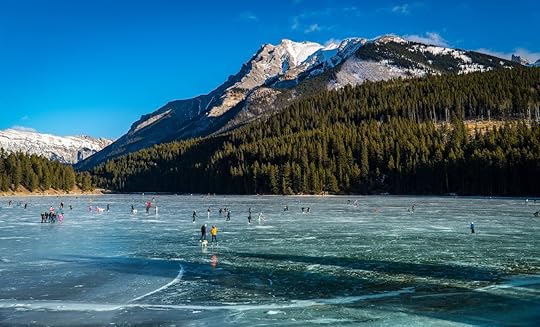
Photo: Aaron John Garcia/Shutterstock
Set beneath the rugged, snow-capped peaks of the Canadian Rocky Mountains, with the magnificent Victoria Glacier looming large in the distance, Lake Louise is one of the most picturesque places in a park with no shortage of world-class natural attractions.
A popular spot for all kinds of winter activities, from December to mid-April, Lake Louise is maintained by the Fairmont Chateau hotel’s ground crew, which helps ensure the lake surface is safe for visitors to venture out on. You can also rent ice skates right by the lake. For a truly serene experience, dance across the ice after dark when most of the tourists have retreated to the warmth of the Fairmont Chateau fireside.
Vermilion Lakes — Banff National Park, Alberta, Canada

Photo: achinthamb/Shutterstock
This chain of lakes just west of Banff is renowned for breathtaking sunrises and sunsets, and it’s a haven for hikers and photographers during the summer months. In winter, though, the lakes are a peaceful alternative to the bustling holiday hub of Lake Louise.
Against a panoramic backdrop of craggy mountain peaks, skaters can expect to have the three lakes almost entirely to themselves. While it’s imperative that you test the depth and strength of the ice first, it’s reassuring to know that the water is little more than knee-deep in most parts, should you suddenly find yourself in the unenviable situation of seeing the surface starting to split apart underneath you.
Lake Bogstadvannet — Oslo, Norway

Photo: 0399778584/Shutterstock
Several lakes in the wooded forests on the outskirts of Oslo are popular winter skating spots. Bogstadvannet is only the second largest among them, but it’s one of the most popular. On any stormless winter day during the few hours that the sun is out, you’ll find ice skaters there. Hemmed in by thick Nordic woodlands, stunning Bogstadvannet is only 20 minutes from the middle of Oslo.
Lush, green, and flanked by sandy beaches in summer, in winter Bogstadvannet becomes a picturesque natural ice skating rink. Early in the morning, you can see the silhouettes of skaters emerging from shrouds fog floating across the surface of the lake. Skating on Bogstadvannet is equally magical in the afternoon before the winter sun sinks behind the forested hills in the distance.
Lake Mälaren — Stockholm, Sweden
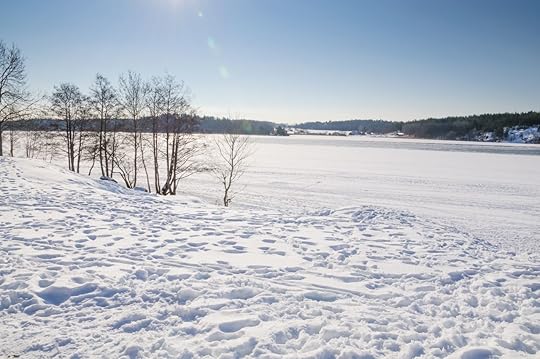
Photo: Artesia Wells/Shutterstock
You don’t have to travel far from Sweden’s capital to find yourself surrounded by world-class natural ice skating rinks. Just outside the city, the frozen waterways of the Stockholm Archipelago and its surrounding lakes combine to create one of the planet’s most epic ice-skating environments. Within minutes from the capital city, you can set out on a cross-country skate adventure for days on end.
Just an hour’s drive out of Stockholm, you can embark on a Nordic skating adventure on the crystal clear black ice of Lake Mälaren. Spanning 440 square miles in total, it’s the fifth largest in Europe. While much of the lakeshore is densely wooded, the Mälaren region is also extremely rich in history. A number of beautifully preserved monuments from the Imperial Age still stand at the lake’s edge, among them the imposing, onion-domed Gripsholm Castle. Where else but Sweden can you ice skate on one of the world’s most beautiful lakes and find yourself zipping past the fairytale-like facade of a baroque 17th-century castle?
Evergreen Lake — Evergreen, Colorado
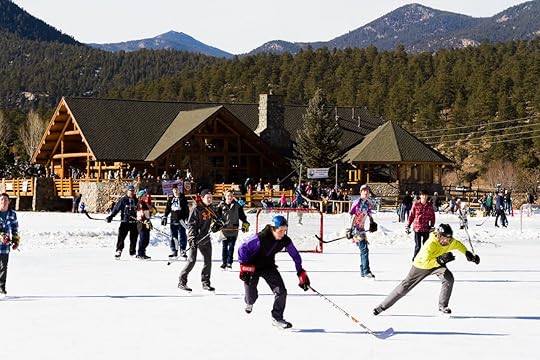
Photo: Arina P Habich/Shutterstock
Most natural skating areas in the continental US are on smaller lakes and ponds in the northern midwest states and in the Northeast. However, a very big body of water where you can enjoy an authentic natural ice skating experience is Colorado’s mighty Evergreen Lake. It spans 40 acres and is encircled by dense thickets of lodgepole and ponderosa pine that stay verdant and vibrant year-round — hence the lake’s name.
Evergreen may be one of the world’s largest groomed outdoor ice skating rinks, using a Zamboni to make the icy surface usable for local ice hockey teams, as well as for visiting families on a leisurely afternoon skate. You can rent ice skates on site. Since it’s only a 40-minute drive west of Denver, Evergreen is an easy day trip — although cozy wood cabins for an overnight stay aren’t far from the lake shore.
Portage Lake — Alaska, United States
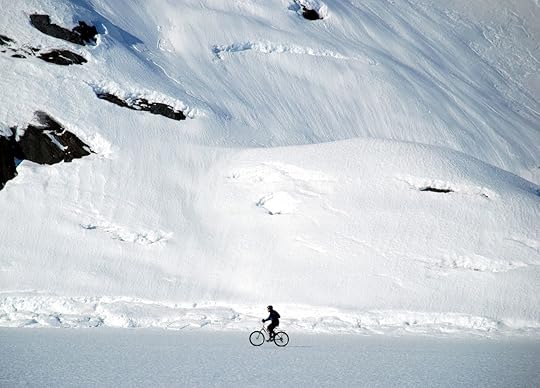
Photo: alanbassett/Shutterstock
The frozen wilderness of Alaska is the ultimate destination for backcountry skaters in pursuit of the perfect expanse of pristine wild ice. In south-central Alaska, hardcore adventurers seek out solidified rivers, lagoons, and even ice caves for an adrenaline fix, weaving their way across a frozen minefield of icebergs and snowdrifts. The very deep Portage Lake in Chugach National Forest is paradise for wild ice chasers. Three miles long and almost a mile wide, it’s situated at the foot of Portage Glacier, a monolith of shimmering blue Arctic ice. If you’re so inclined, you could also ride across the frozen lake on a fat bike outfitted for winter conditions.
Great Slave Lake — Northwest Territories, Canada

Photo: Sophia Granchinho/Shutterstock
Canada has no shortage of magnificent natural ice skating destinations, and few are more spectacular than the Arctic lakes of the Northwest Territories. Great Slave Lake, near the regional capital of Yellowknife, is the 10th-largest lake in the world. In winter, it solidifies into a glittering frozen expanse, stretching as far as the eye can see. You can ice skate on the lake for close to half of the year. In late March, it hosts the Long John Jamboree, inviting skate-clad revelers to enjoy a final blast before the spring melt.
Just 250 miles shy of the Arctic Circle, the shape-shifting lights of the aurora borealis sometimes appear in the night skies above Yellowknife, illuminating the surface of Great Slave Lake with pulsating streaks of cosmic color.
Lake Baikal — Eastern Siberia, Russia
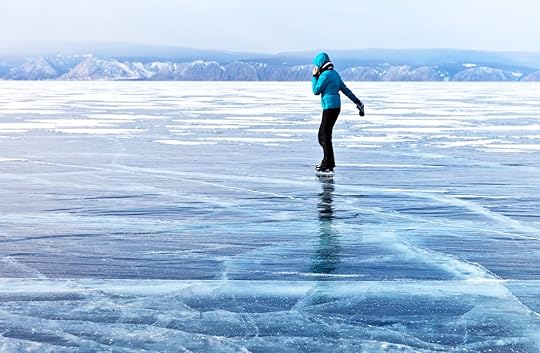
Photo: Katvic/Shutterstock
It may be no quick jaunt, but if you can manage to make it to Siberia, you’ll be rewarded with the most stunning ice skating experience on Earth. The world’s deepest lake, home to around a fifth of the world’s freshwater, covers a staggering 12,248 square miles. Baikal is larger than Belgium and contains more water than all the North American Great Lakes combined. What makes this World Heritage-listed wonder even more remarkable is that the entire surface is completely frozen over in winter. Between November and April, Lake Baikal becomes the biggest ice skating rink on the planet.
The ice averages over a foot thick and is so translucent that you can peer straight through it into the ink-black, unfrozen depths of the abyss below. In 2012, five adventurers — among them photographer Daniel Korzhonov — set out on a 250-mile, two-week journey, crossing Lake Baikal from north to south on ice skates. We suppose if you’ve flown that far to ice skate, you might as well make the most of it. 

More like this: The best ski trails in US national parks
The post The world’s most beautiful lakes you can ice skate on appeared first on Matador Network.

Matador Network's Blog
- Matador Network's profile
- 6 followers



